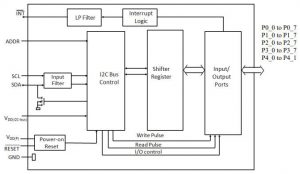
Both interface to the host controller though a variable voltage I2C interface and interface to the outside world thorough variable voltage IO pins.
The thresholds for the I2C-bus interface are set by a reference voltage input, intended to be connected directly to the Vdd of what ever is at the other end of the I2C bus. Thresholds for GPIO ports are set by a second voltage reference input. These voltage reference inputs also supply power to the chip.
- PI4IOE5V6416Q has 16 IO pins and comes in TSSOP-24
1.65 – 5.5V on I2C side up to 400kHz
1.65 – 5.5V on IO side - PI4IOE5V6534Q has 34 IO pins and comes in W-QFN4565-46 (SWP) with wettable-flanks
0.8 – 3.6V on I2C side up to 1MHz (‘fast mode plus’)
1.65 – 5.5V on IO side
“This allows them to interface with next-generation microprocessors and microcontrollers on the SDA/SCL side, where supply levels are reducing to conserve power, according to the company. They “provide a simple solution when additional I/Os are needed while keeping interconnections to a minimum, for example for interfacing to sensors, push buttons or a keypad”.
At power-on, all IOs are configured as inputs, after which the host can change this by writing to the IO direction register. There is also a separate reset input pin.
Output pins can be set as push-pull or open-drain. Four output drive strengths are available (2.5, 5, 7.5 or 10mA) to adjust rise and fall times. Outputs can pull down up to 25mA – to drive LEDs, for example.
An additional open-drain output is available to send interrupts to external processors. Masking allows the user to route the interrupt from individual inputs.
Inputs can be floating or have a pull-up-or a pull-down Resistor, and switch de-bounce hardware is included and can be associated with any number of input pins.
In the 34 IO version, stand-by power consumption is typically 2μA from the port reference/supply pin at 3V. For the 16pin version, this figure is typically 1 µA – or 1.5 µA from 5V. Max supply current depends on settings, but does not get above 625μA (34 IO version, unloaded outputs).
Operation is across -40°C to +105°C.
As well as AEC-Q100 qualified, they are PPAP-capable and manufactured in IATF 16949 certified facilities
The product pages are here:
PI4IOE5V6416Q
PI4IOE5V6534Q